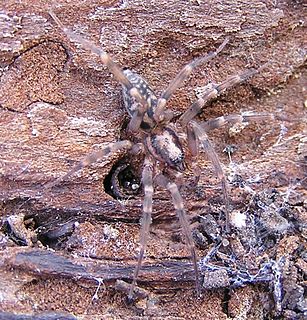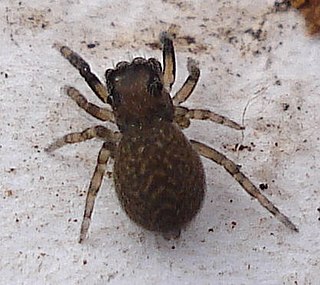
Pirate spiders, members of the family Mimetidae, are araneomorph spiders which typically feed on other spiders.

Liocranidae is a family of araneomorph spiders first described by Eugène Simon in 1897. They are one of several groups called "sac spiders". The holarctic genus Agroeca is the best-known, but it also includes various genera of more obscure spiders that still lack a diagnosis. Two species in the North American genus Neoanagraphis are found in the extremely dry conditions in the Mojave, Sonoran and Chihuahuan deserts. Females live in animal burrows while males wander and are the ones most often caught in pitfall traps.

Semper Paratus is a Latin phrase, meaning "Always Ready". Sometimes shortened to Semper P. It is used as the official motto of some organizations, such as the United States Coast Guard. A 1928 song of the same name is also used as the U.S. Coast Guard's official march, and appears on the organization's flag.
Crotaphytus reticulatus, commonly called the reticulate collared lizard, is a species of moderately sized lizard in the family Crotaphytidae. The species is native to semiarid, rocky regions of the Tamaulipan mezquital. Its range includes the American state of Texas and the Mexican states of Coahuila, Nuevo León, and Tamaulipas. Of all the species in the family Crotaphytidae, C. reticulatus is the only species which is not restricted to rocky habitats.

Neon is a spider genus of the jumping spider family, Salticidae. Its described species occur mostly in Eurasia, with some species found in North and South America. One species, N. convolutus, is also found in Algeria. Two species are known from Australia, N. australis and N. taylori. N. australis has palp morphology and fringing on its first pair of legs very similar to that seen in N. nojimai Ikeda 1995, from Japan. N. taylori is most similar in morphology to N. sumatranus from Indonesia and N. kovblyuki from the Crimea and elsewhere. The genus is common and widespread in litter throughout Australia, from the highlands of Tasmania through the hot, dry inland to the wet tropics and includes many undescribed species.
Oarces reticulatus is a spider species in the family Araneidae.

"Semper Paratus" is a 1928 song and the official march of the United States Coast Guard, having been composed in 1927 by U.S. Coast Guard Captain Francis Saltus Van Boskerck.

The spiked Atlantic spiny-rat or Espirito Santo spiny rat, is a spiny rat species from South America. It is found in Brazil.

Chiloglanis is a genus of upside-down catfishes native to Africa. These species have modified lips and barbels that form a suckermouth. They also have a naked (scaleless) body. Sexual dimorphism has been reported in Chiloglanis. The adult males of many of these species have elongate anal and caudal fins. Also, males may have an enlarged humeral process.

Neon valentulus is a species of jumping spider found from Europe to Central Asia. It is only found in marshy areas.
Chiloglanis paratus, the sawfin suckermouth, is a species of upside-down catfish native to Mozambique, South Africa, Swaziland and Zimbabwe where it is found in the Pongolo, Incomati and Limpopo River systems. This species grows to a length of 8.5 centimetres (3.3 in) SL.

Orectolobus reticulates, the network wobbegong, is a recently described species of carpet shark found in relatively shallow waters off Kimberley and Darwin in north-western Australia. With a known maximum length of only 52.3 centimetres (20.6 in), it may be the smallest species of wobbegong. Until its description in 2008, it had been confused with the northern wobbegong.

Oreaster reticulatus, commonly known as the red cushion sea star or the West Indian sea star, is a species of marine invertebrate, a starfish in the family Oreasteridae. It is found in shallow water in the western Atlantic Ocean and the Caribbean Sea.

Glyptagnostus reticulatus is a species of agnostid trilobite belonging to the genus Glyptagnostus. It existed during the Paibian Age of the Cambrian. It has a cosmopolitan distribution and is an important index fossil in biostratigraphy. It was characterized by an unusual net-like pattern of furrows on both the cephalon and the pygidium.
Paratus is a genus of araneomorph spiders in the family Liocranidae, containing five species restricted to India, Sri Lanka and China.

Neon nelli is a species of jumping spider in the family Salticidae. It is found in the eastern United States and Canada.

Cybaeus reticulatus is a species of true spider in the family Cybaeidae. It is found in the United States and Canada. It was first described by Eugène Simon.

Neon reticulatus is a species of jumping spider in the family Salticidae. It is found in North America, Europe, Turkey, Caucasus, a range from Russia (European to the Far East, Kazakhstan, Korea, and Japan.












